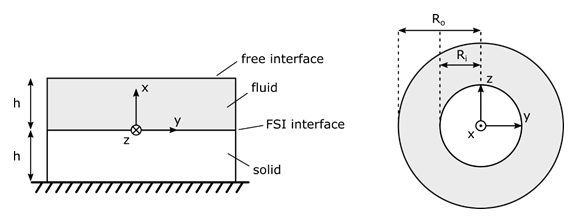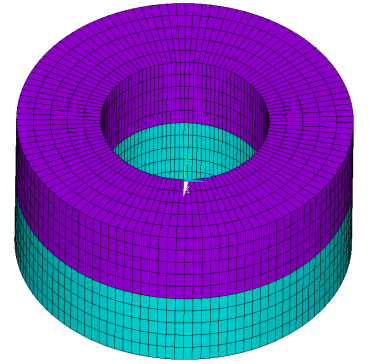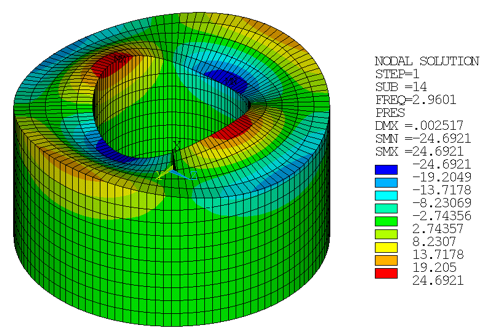VM304
VM304
Sloshing Modes in a Hollow Cylindrical Cavity
Overview
| Reference: | Robert D. Blevins. Formulas for Natural Frequency and Mode Shape. Krieger, 2001. |
| Analysis Type(s): | Modal Analysis (ANTYPE = 2) |
| Element Type(s): |
3D 20-Node Acoustic Solid (FLUID220) 3D 20-Node Structural Solid (SOLID186) |
| Input Listing: | vm304.dat VM304 requires a supplemental .cdb input file which is too long to include full input listings. This file must be downloaded and placed in your working directory for the test case to run properly. Additionally, the geometry and mesh should be regenerated. Download link: MAPDL Test Case Files for 2024 R2 vm304.cdb |
Test Case
The cavity consists of two stacked hollow cylinders. The bottom cylinder is made of steel. The top cylinder contains water.
Both cylinders have inner radius Ri and outer radius Ro. The bottom of the lower cylinder is clamped.
Fluid-Structure Interaction (FSI) at the interface between fluid and solid is considered.
The fluid lateral boundary is a rigid wall and the top surface is free.
| Material Properties | Geometric Properties |
|---|---|
|
For fluid: Speed of sound c0 = 1500 m/s Density ρf = 1000 kg/m3 For solid: Young’s modulus E = 1.44 x 1011 Pa Poisson’s ratio ν = 0.35 Density ρs = 7700 kg/m3 | Inner radius Ri = 0.1 m Outer radius Ro = 0.2 m Height h = 0.1 m |
Analysis Assumptions and Modeling Notes
In Mechanical APDL, pressure in a fluid medium is determined by the acoustic wave equation; therefore, the pressure considered is the excess pressure from the mean pressure. That pressure is used in the modal analysis to determine the sloshing frequencies and mode shapes.
Results Comparison
| First 10 Natural Frequencies | |||
|---|---|---|---|
| (i, j) [1] | Target | Mechanical APDL | Ratio |
| (0,1) | 0.9963 | 0.9963 | 1.000 |
| (0,2) | 1.7042 | 1.7042 | 1.000 |
| (0,3) | 2.1755 | 2.1756 | 1.000 |
| (0,4) | 2.5214 | 2.5215 | 1.000 |
| (0,5) | 2.8064 | 2.8016 | 0.998 |
| (1,0) | 2.8184 | 2.8140 | 0.998 |
| (1,1) | 2.8560 | 2.8523 | 0.999 |
| (1,2) | 2.9623 | 2.9601 | 0.999 |
| (0,6) | 3.0449 | 3.0435 | 1.000 |
| (1,3) | 3.1210 | 3.1203 | 1.000 |






